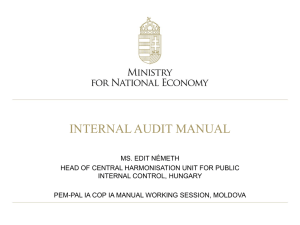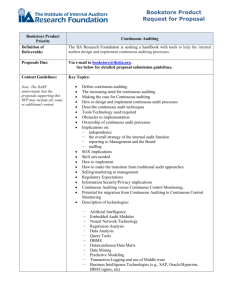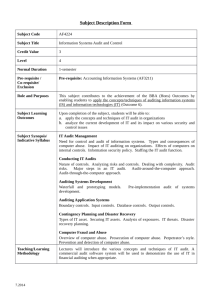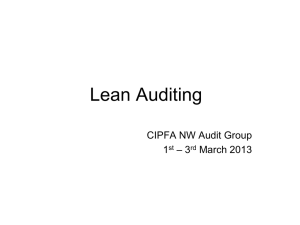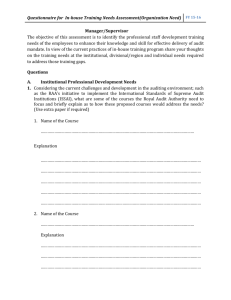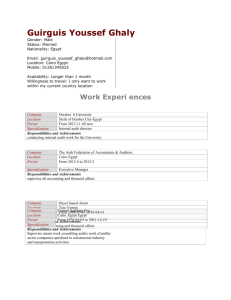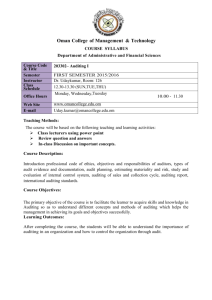The Antecedents of Internal Auditors* Adoption of
advertisement
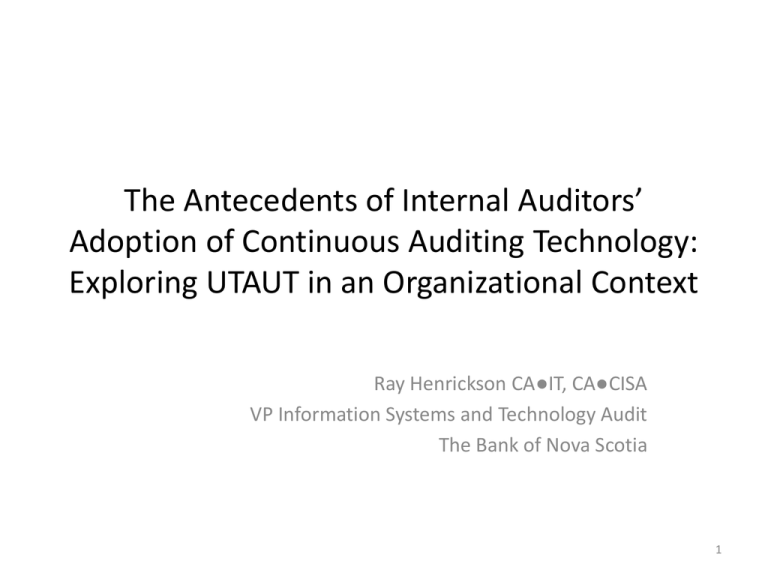
The Antecedents of Internal Auditors’ Adoption of Continuous Auditing Technology: Exploring UTAUT in an Organizational Context Ray Henrickson CA●IT, CA●CISA VP Information Systems and Technology Audit The Bank of Nova Scotia 1 Background • System environment – Complex, integrated systems • Millions of financial transactions a day • +1,000 systems • Thousands of changes per year – Total prohibition to access PROD – Comprehensive and mature user controls – Extensive use of end user computing for MIS • Audit environment – Limited audit resources – Deep and varied technical and business skills – Extensive collaboration with IT and business units 2 CA in My Environment • Work with IT and business areas to develop and implement continuous “auditing” that is executed by them – Transaction level – online payments verification – System level – cyclical verification of changes – Process level – cyclical end point security scans • Each of the determinants is important but not equally at the same time • Key moderator = risk 3 Why “This puzzling lag …” • Why isn’t continuous auditing the norm? • Doesn’t answer the question directly • Tested several hypotheses related to the adoption of CA through analysis of relationships among select determinants and moderators based on Unified Theory of Acceptance and Use of Technology (UTAUT) 4 Two Sets of Conclusions • Likelihood of adoption is greater if: – The technology is easy to use – Superior instructs to implement – The auditor chooses to obey • No relationship with: – Usefulness and performance expectations – Availability of supporting tools or organization 5 Revised Conclusion • Likelihood of adoption is greater if: – The technology is easy to use – Few organizational or technical infrastructure barriers • No relationship with : – usefulness and performance expectations – Influence of superiors – Willingness to implement 6 Additional Observations • #1 Benefit of CA was accuracy, not timeliness • #1 Focus of CA was for fraud 7 To This Practitioner … • Both conclusions appear reasonable and well supported with analysis although unexpected • Not able to concur or disagree because not enough context provided 8 Issue – Survey Population • Institute of Management Accountants – Not auditors • Low response rate – 2.33 % • Limited respondent detail – – – – – – – Industry/business sector Size/maturity of audit department Uses for continuous auditing techniques Why continuous auditing needed One time or programmatic implementation Decision to stop continuous auditing Influence of risk assessment 9 Issue – Jargon • Continuous what? – Continuous auditing – Continuous control assessment – Continuous risk assessment – Continuous monitoring • What is “continuous”? – Frequency of execution – short audit cycle – Timeliness of execution – real or near real time – Point of execution – close to evidence creation 10 Issue - Methods • Type of technique – Embedded audit module – Independent review of data files/copies – Analysis of reports • Type of technology – – – – – Desktop technology – Access, Excel Audit software – ACL, IDEA Custom developed applications Embedded functionality of vendor package Special purpose analytical software 11 Issue –Control Variable • Replace UTAUT control variables Gender, Age and Experience with Annual Sales • Implied bias towards financial transaction integrity • Could consider audit-related variables such as: – Internal Audit annual budget – Size of Audit Department – Volume/complexity of transactions 12 But, Is the Premise Valid? • Implies new use of stand alone automated checking of transaction qualities • Reflects a “gotcha” objective – fraud, malice, error • Implied bias towards financial transaction integrity – Is there a definition issue? – Is there an expectation gap? – Is research too narrowly focused 13 Today’s Reality • Many mature or modern systems now include embedded control functionality that can be optionally enabled – – – – MIS – performance metrics Reports of discrepancies Posting to suspense accounts Built in checks – auto balancing • There may be greater deployment of continuous auditing in organizations than recognized in literature 14 Alternate Premise • Relate to how and how often the enterprise checks or verifies its automated events, transactions, or data in order to proved an opinion on its desired qualities – Maybe CA is not needed – Maybe CA is useful only for specific cases – Maybe CA is already pervasive 15 Future Research • Follow up to see if the respondents realized their plans for future implementation • Where have CA techniques been most successfully applied and why • Why CA initiatives fail to continue 16 Value of the Work • Most suitable for IS Assurance academics • Might be useful for standard setting or professional practice bodies such as IIA, ISACA, CICA, AICPA • Limited practical application 17


